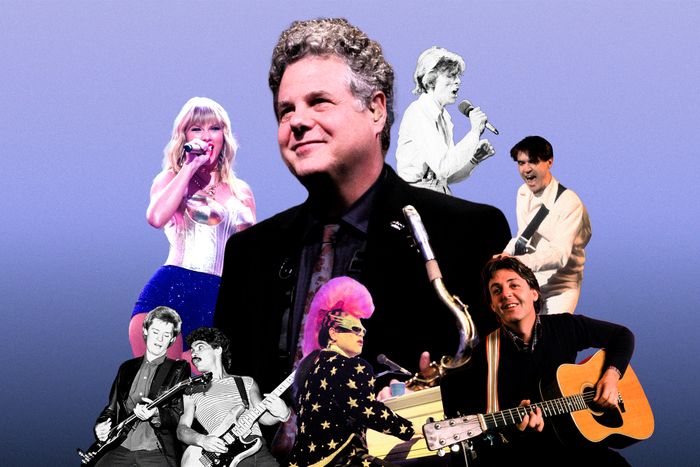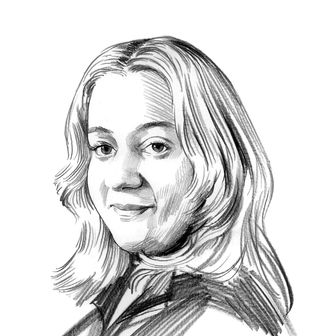
If you’re making an annual pie chart to determine which Saturday Night Live cast members receive the most screen time each season, you may as well add Lenny Pickett to the mix. Nearly 40 years into his tenure, Pickett’s sounds have become as synonymous with Studio 8H as a “Weekend Update” segment. There he is, hovering over the host’s shoulders as the musical director and saxophonist of the SNL Band, patiently waiting for the monologue wrap so he can go wild on the reeds again. “I’ve always enjoyed playing in front of an audience and the spontaneity that comes when you know you have to get it right,” he explains. “In the studio, you can do multiple takes. But on live television, it just happens.”
And boy, does Pickett know his way around a studio. Prior to being hired by SNL in 1985, he was an in-demand session musician whose band, Tower of Power, were the go-to cats for adding a horn section to any record. This funky prolificacy continued with the Borneo Horns, a sax trio he co-founded in 1982 that lent their talents to some of the most consequential artists of the era. To celebrate SNL’s 50th-anniversary season, Pickett took us through his most cherished and significant recordings.
Tower of Power, “Soul Vaccination” (1973)
I just joined the band and was 18 years old. I went from being out of work to fully employed. We came about during the time that the music scene in San Francisco was growing because of the psychedelia that preceded it in the late 1960s. A lot of record labels parked their offices in San Francisco to take advantage of the acts that were around. Tower of Power was an indigenous local group made up of a real mixture of ethnicities and backgrounds — mostly working-class kids.
This was my first time in the studio recording a solo for Tower of Power. They gave me all the time in the world I needed for it, so I took multiple sessions to get it right until I was happy. It was a big learning curve. Performing in the studio is a very different thing than performing live. When you’re playing live, you have an audience in front of you, which I much prefer. But in the studio, it’s you, the producer, and the engineer — and the engagement with the engineer is critical because your headphone mix has to be just right and they have to be able to capture your sound.
Elton John, “The Bitch Is Back” (1974)
I had a saxophone solo on “The Bitch Is Back,” which was a revelatory experience. Tower of Power was back out on the road right after the session, so everywhere we were traveling, we were hearing the song on the radio. Elton John wasn’t there when I recorded and it occurred at Sound City in Los Angeles, which is the famous studio Dave Grohl did a documentary about. The City was a recording mecca and we were often traveling back and forth down there to do sessions with artists. This was intense — two or three days I spent doing this. It was a very short period of time. Worth it, of course.
Little Feat, “Mercenary Territory” (1977)
I met Little Feat on a tour. Warner Brothers put it together and we had a train that traveled all over Europe. Tower of Power had our own special train cars. We met the Rolling Stones and we finally met Elton John. But meeting Little Feat was fortuitous and spurred three albums with them. This version was recorded live at the Rainbow Theater in London. It’s the solo I played on the record. People, including myself, acknowledge Waiting for Columbus as one of the most amazing live albums because it really captures the feel of a “live experience,” but the recording is very clear and very clean. Little George started the solo and I took off from where he left off.
David Bowie, “Blue Jean” (1984)
I recorded with David Bowie at Lake Studio in Morin-Heights, Canada. It was my debut as an arranger. I wrote horn parts and played a short solo on “Blue Jean.” It followed David’s Serious Moonlight Tour. I was part of a group of horns on the tour with Stan Harrison and Steve Elson, and we fancied ourselves as the Borneo Horns. I had met David when he was touring for Let’s Dance. I was asked by him to write charts and play on his follow-up record, Tonight. We were sequestered out in the woods in this studio. Back in the day, they would put studios in out of the way places to protect the artists from being mobbed by fans. This was up in a rural area outside of Montreal, so it was just the Borneo Horns, David, and the engineer. It was a few days of work. We had our meals there and we were in constant touch with one another. David was in the studio all the time. When we were recording, he was in the control room. He was very hands on with the whole process.
Hall & Oates, “The Way You Do the Things You Do” (1985)
This was recorded with Eddie Kendricks and David Ruffin from A Night at the Apollo Live! I got the job through a connection I had with a remix producer who did a lot of those 1980s remixes of other people’s hits. He was friends with Tommy Mottola, who was managing Hall & Oates at the time. He called me for this session. It was last minute and behind schedule. I also put together charts on the floor of the dressing room backstage at the Apollo. I have a solo on “The Way You Do the Things You Do.” But this ended up being perhaps the biggest session of my career, because I met G. E. Smith, who became the guitar player and band leader at Saturday Night Live a year later. He was working with Hall & Oates during this period. And that’s how I got the audition to do the show. G.E. remembered my playing on this record, gave me a call, and invited me to come and play for Howard Shore.
Paul McCartney, “Stranglehold” (1986)
This came about because of a personal recommendation from Carlos Alomar, who was the guitar player on David Bowie’s Let’s Dance Tour. Finally, I played with a Beatle!
Talking Heads, “Blind” (1988)
This is a good example of my horn arranging at the time. I didn’t play any solos for Talking Heads, but I wrote the arrangements for two of the album’s songs, “Blind” and “Big Daddy.” This is my favorite of the two. It used a lot of the techniques that I used in writing for the Borneo Horns and some esoteric harmonies in the sustained sections. David was very open to that. He was experimental in nature and very receptive to the writing that I’d done. I have to say, the band was getting along pretty well for their final album. Tina Weymouth, Jerry Harrison, and Chris Franz were all in the studio most of the time with David. They were all collaborating. And from that project, Tina and Chris called me for a couple of Ziggy Marley records, and Jerry called me to help with a solo album. It was a session where I made a lot of connections with musicians.
Allen Ginsberg, “Stanzas — Written at Night in Radio City” (1989)
I did all of the instruments myself, which was new. I played 15 different ones and recorded them to match Allen’s reading. He read the poem first, and then I orchestrated it around his reading. It was no different from a regular studio session with a musician. The way Allen read was very rhythmic, like a song. It was a little bit like scoring a film to dialogue, or writing a song after the lyrics are already recorded. Hal Willner produced it. He chose the sketch music for Saturday Night Live for years. It was nice to combine those two different professional worlds.
Little Richard, “Rubber Duckie” (1994)
You always want to get on Sesame Street. That’s me playing the solo but they had an owl puppet doing the saxophone in the music video. Little Richard was … very intense.
Taylor Swift, “False God” (2019)
Because I’m so occupied with my duties at Saturday Night Live, my work as a session musician declined in the 1990s. It changed the amount of recording I could do. I did do a little bit of studio work, but one day I looked up and the whole idea of a music scene changed. But I’m particularly proud of Taylor Swift’s appearance that she did live on SNL. It was very interesting because it was the first time I did a track with a “contemporary singer.” Usually the things I had done before were for older or more established acts. I mean, for comparison, I played with Aretha Franklin and Mariah Carey. What I heard in my headphones was different. This was very modern. There’s a click track, backing parts, and other elements that aren’t in the studio. It’s an interesting point of view. Taylor was so great. We had all the rehearsal time we needed and she was very encouraging. It was a very good experience.


